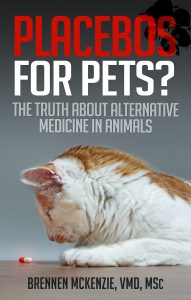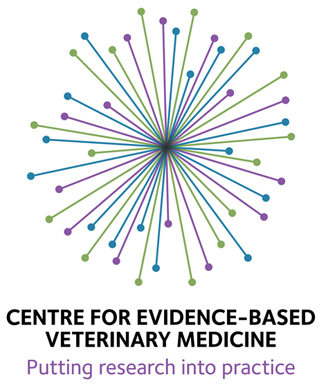There are many reasons why therapies which don’t actually have a physical effect on a disease may appear to work anyway (an extensive list of which can be found under Can We Trust Clinical Experience? at my website). One of the best known, and misunderstood, is the so-called Placebo Effect.
Though this is generally used to mean any positive effect of a treatment that isn’t actually affecting the underlying disease, it really should apply more narrowly to perception-mediated non-specific effects of a treatment. In humans subjective perception of discomfort (pain, nausea, anxiety, etc) often improves with any treatment, and this seems to be largely due to the effects of expectation, diversion of attention, and classical conditioning. Objectively measurable physical parameters can be altered by the placebo effect, but disease progression and outcome are not.
In animals, the influence of expectation and diversion of attention do not seem to play a role in the placebo effect, but nonspecific effects of ineffectual treatments are seen. One possible reason for this is classical conditioning. Dogs exposed to food and a ringing bell can be conditioned not only to salivate and look for food but to secrete stomach acid when the bell is rung. Animals repeatedly given insulin injections, which lower blood sugar, can then manifest a decrease in blood sugar when given a saline injection. So the experience of feeling better after receiving true treatment for disease in the past could possibly condition a mild, transient improvement from the same treatment environment in the absence of a truly effective therapy.
There are other possible explanations for a placebo-like effect in veterinary patients (stress hormone release associated with the vet visit, changes in owner management during a period of concern, etc). Probably the most significant, however, is what I call the “placebo effect by proxy.” Owners have a strong desire to see their pets get better. They also have a desire see the worry and expense of a vet visit validated by improvement. Confirmation bias, cognitive dissonance, and old-fashioned wishful thinking can all make therapies initially seem to work even when they are doing nothing. And in cases where other factors such as regression to the mean of chronic symptoms, spontaneous resolution of disease, and misdiagnosis lead to a true resolution of the complaint, useless therapies may seem to work, the patient will get better, the owner will be happy, and the vet will get the credit. So what’s wrong with that?
Well, for one thing taking advantage of a direct or proxy placebo effect requires deception. The patient or client must believe they are being given a real therapy. In fact studies have shown that the more confidence with which a doctor presents a placebo to a patient, the more effect it has.
Introducing deliberate deception into the medical relationship strikes me as an ethical and practical quagmire. As a vet, people trust me to do painful, costly things they don’t always fully understand to their family members. This trust requires that I be honest with them, and there is no effective way to do this and still utilize therapies I believe to be ineffective. At best, I could say, “Treatment X has not been proven to be beneficial but anecdotally some people have reported a positive response…” Such a weak presentation would likely diminish the desired non-specific effects while not really solving the ethical problem.
In the veterinary setting, the placebo is likely working much better on the owner than the patient. So while I might get some undeserved credit for a bogus treatment, the patient is still suffering. And since not all placebos are without risks (such as the still apparently common practice of prescribing antibiotics for viral infections), utilizing them can even present a small risk of doing harm for no true benefit in terms of the disease, regardless of whether the patient or client perceives a benefit.
I once denied a client a prescription for antibiotics for their cat, who had bloody urine. The particular circumstances indicated the cat had a vanishingly small chance of having a bacterial infection (no more than 2% in one study), while the incidence of vomiting, anorexia, and diarrhea from the antibiotic was much higher (about 10-15%). The clinical signs in such cases usually go away by themselves in about 7 days. The client was irate and went to my boss, who gave her what she wanted.
When I challenged him for doing so, I pointed out that he would get credit for solving the problem when what he had done only satisfied the owner, did nothing for the pet, and exposed the patient to an unnecessary risk. He felt that if the pet got better, the client was happy, and he got the credit it was a win for everybody, and he couldn’t see any ethical dilemma. He was also a much older doctor who had trained at a time when human medicine still followed the paternalistic model, doing what the doctor thought best without regard for the patient’s wishes. That model has been rejected by mainstream human medicine, and it has not place in veterinary medicine either.
It is common for vets and doctors who are not believers in alternative therapies to utilize them anyway because they make clients or patients happy. These providers generally rationalize this by saying that the risk is low (which it generally is) and that a true benefit is at least possible (which it often is not). However, they fail to include in this calculation the risks, and the raw ethical problem, of deliberately deceiving the client or patient. And they ignore the very real practical problem of encouraging belief in ineffective or unproven therapies and the epistemological and philosophical paradigms that often accompany them, and which are generally very anti-scientific.
While there is always some uncertainty about the risks and benefits of any treatment in a given clinical situation, and while honesty does not always require a lawyerly detailing of these that creates pointless anxiety, using clearly disproven approaches, and even implausible treatments that have not been thoroughly tested, requires us to violate the trust our clients and patients give us for a superficial and transient benefit, which in the veterinary setting does not even apply to the actual patient. It may be more difficult to deserve this trust with sometimes uncomfortable honesty, but I am convinced this is the right path to take, ethically and practically.









